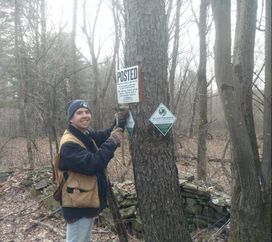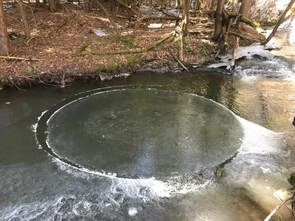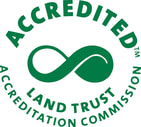Introducing Garrett Chisholm, Stewardship Coordinator
Chisholm Talks About His New Role at the Preserve with Michaela Fisher, Membership and Outreach Coordinator
MF: What brought you to a career in land stewardship and conservation?
GC: I spent summers growing up on Monhegan Island, a rocky, undeveloped setting approximately 12 miles off the coast of Maine. It was there that I built an everlasting connection with the natural world, and to which I credit my desire to work in the field of conservation. When I began my college career at the University of Vermont (UVM), I wanted to learn how to protect natural areas so that others could experience them as I had as a child. Much of my undergraduate years were spent in conservation-focused, service-learning courses so that I could fully immerse myself in the Vermont landscape while earning my degree. I graduated from UVM in 2018 with a Bachelor of Science in Environmental Studies with a focus in Conservation and Stewardship. Since then, I have worked for a land trust, spent a season on a trail crew, and completed a service term through AmeriCorps at a state park.
MF: What are some of your outdoor interests?
GC: My favorite outdoor activity is simply walking through the woods. I also enjoy the occasional rock climb or other strenuous outdoor activity such as hiking, biking, or swimming, but I am happiest just being immersed in nature. Rensselaerville is the furthest I have ever lived from the Atlantic Ocean, so I am looking forward to seeing how my outdoor interests will change as I discover the complex landscape of the Helderberg Escarpment and the Catskills.
MF: This is a new position at the Preserve. What are your responsibilities?
GC: As the Stewardship Coordinator, I am responsible for carrying out the Preserve’s land management operations. A main priority will be implementing the Preserve’s new Invasive Species Management and Monitoring Plan in order to protect key areas of the Preserve from invasive plants and forest pests that threaten native species. Some examples include hemlock woolly adelgid, an aphid-like insect threatening the Preserve’s 370 acres of hemlock, and Eurasian watermilfoil, an aquatic invader discovered in Lake Myosotis in 2019. In collaboration with fellow Preserve staff, I will also monitor the land at the Preserve, with an emphasis on the trail system and property boundaries. I will be using Geographic Information System mapping (GIS), a visualization data system that reveals patterns and changes in complex terrestrial data — to help inform land management and land protection decisions. The skills that I have garnered through my previous positions in the field of conservation will be important as I navigate my role as the Stewardship Coordinator at the Preserve.
MF: What are you most looking forward to in your first year in this position?
GC: Apart from having the opportunity to explore the myriad of plant and animal species at the Preserve, I am most looking forward to getting to know the community. I will be working toward building a volunteer crew for stewardship activities at the Preserve. There is ample opportunity for members of our local and regional community to get involved. From my own volunteering experience, I know that even a few well-spent hours can have a significant, positive impact on the land and can, in turn, be deeply rewarding. I am excited to meet and engage new groups, and teach people how to identify an array of native and invasive plant species. This is a skill that will be very valuable at the Huyck Preserve as we carry out our work, and it will be valuable knowledge and awareness that people can take with them wherever they go in the area. I am planning a series of invasive species education and work days and encourage anyone with an interest in volunteering at the Preserve to contact me by email at [email protected]. We are looking to build a real network of Huyck Preserve Volunteer Stewards, and I am eager to get started!
GC: I spent summers growing up on Monhegan Island, a rocky, undeveloped setting approximately 12 miles off the coast of Maine. It was there that I built an everlasting connection with the natural world, and to which I credit my desire to work in the field of conservation. When I began my college career at the University of Vermont (UVM), I wanted to learn how to protect natural areas so that others could experience them as I had as a child. Much of my undergraduate years were spent in conservation-focused, service-learning courses so that I could fully immerse myself in the Vermont landscape while earning my degree. I graduated from UVM in 2018 with a Bachelor of Science in Environmental Studies with a focus in Conservation and Stewardship. Since then, I have worked for a land trust, spent a season on a trail crew, and completed a service term through AmeriCorps at a state park.
MF: What are some of your outdoor interests?
GC: My favorite outdoor activity is simply walking through the woods. I also enjoy the occasional rock climb or other strenuous outdoor activity such as hiking, biking, or swimming, but I am happiest just being immersed in nature. Rensselaerville is the furthest I have ever lived from the Atlantic Ocean, so I am looking forward to seeing how my outdoor interests will change as I discover the complex landscape of the Helderberg Escarpment and the Catskills.
MF: This is a new position at the Preserve. What are your responsibilities?
GC: As the Stewardship Coordinator, I am responsible for carrying out the Preserve’s land management operations. A main priority will be implementing the Preserve’s new Invasive Species Management and Monitoring Plan in order to protect key areas of the Preserve from invasive plants and forest pests that threaten native species. Some examples include hemlock woolly adelgid, an aphid-like insect threatening the Preserve’s 370 acres of hemlock, and Eurasian watermilfoil, an aquatic invader discovered in Lake Myosotis in 2019. In collaboration with fellow Preserve staff, I will also monitor the land at the Preserve, with an emphasis on the trail system and property boundaries. I will be using Geographic Information System mapping (GIS), a visualization data system that reveals patterns and changes in complex terrestrial data — to help inform land management and land protection decisions. The skills that I have garnered through my previous positions in the field of conservation will be important as I navigate my role as the Stewardship Coordinator at the Preserve.
MF: What are you most looking forward to in your first year in this position?
GC: Apart from having the opportunity to explore the myriad of plant and animal species at the Preserve, I am most looking forward to getting to know the community. I will be working toward building a volunteer crew for stewardship activities at the Preserve. There is ample opportunity for members of our local and regional community to get involved. From my own volunteering experience, I know that even a few well-spent hours can have a significant, positive impact on the land and can, in turn, be deeply rewarding. I am excited to meet and engage new groups, and teach people how to identify an array of native and invasive plant species. This is a skill that will be very valuable at the Huyck Preserve as we carry out our work, and it will be valuable knowledge and awareness that people can take with them wherever they go in the area. I am planning a series of invasive species education and work days and encourage anyone with an interest in volunteering at the Preserve to contact me by email at [email protected]. We are looking to build a real network of Huyck Preserve Volunteer Stewards, and I am eager to get started!




